Heian Jingu is among the newest shrines of Japan. It was built in 1895 as part of the Industrial Exhibition Fair, to commemorate the 1100 year anniversary of the establishment of Kyoto, then known as Heian-kyo. In the beginning, Heian Jingu only enshrined emperor Kanmu, the founder of Kyoto. However, in 1940, emperor Komei was deified and, as the last emperor to reside in Kyoto, was also enshrined here. The shrine is popular with the locals because it was an attempt to halt Kyoto’s decline after the capital had moved to Tokyo – and it did work! So, when it burnt down completely due to arson in 1976, it only took three years to rebuild it. Today, Heian Jingu is considered an Important Cultural Property.
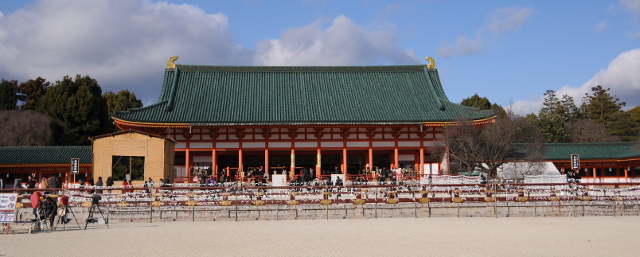 Heian Jingu as a whole is a replica of the ancient imperial palace Daidairi, built at the founding of Kyoto, and destroyed in 1227. The shrine is built in the official compound structure style Chodo-in, on a 5/8-scale of the original. The final designs were made by architectural historian Ito Chuta, and the colorful buildings and vast spaces between them have a distinct Chinese charm, that was very popular during the Heian period. It also gives the shrine a grand and stately atmosphere.
Heian Jingu as a whole is a replica of the ancient imperial palace Daidairi, built at the founding of Kyoto, and destroyed in 1227. The shrine is built in the official compound structure style Chodo-in, on a 5/8-scale of the original. The final designs were made by architectural historian Ito Chuta, and the colorful buildings and vast spaces between them have a distinct Chinese charm, that was very popular during the Heian period. It also gives the shrine a grand and stately atmosphere.
The first building to greet visitors in the impressive, two-storey Otenmon gate in vermillion, green, and white, once the main gate of the old Heian palace. However, the official entrance to the shrine is 500 m further to the south, at the huge torii, one of Kyoto’s landmarks. Interestingly, the torii was erected only in 1929, when, with a hight of 24,4 m and legs that boast a diameter of 3,6 m, it was the largest torii in Japan.
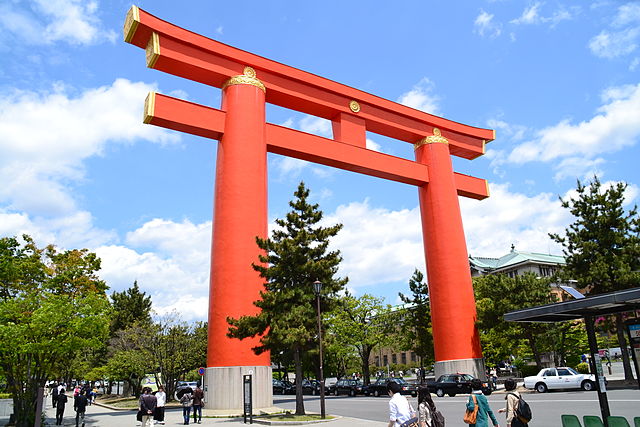 Passing through the Otenmon gate, the shrine opens up into a large courtyard, at the north of which lies the Daigokuden, the Great Hall of State, where once the emperor conducted the state affairs. The Daigokuden is divided into three parts: In the Gaihaiden front shrine, people come to worship and buy good luck charms. Behind it lies the inner sanctuary, which was once used only for imperial ceremonies, but today, shinto ceremonies like weddings or the popular shichi-go-sai shrine visits for kids take place here. At the very back lies the main sanctuary, where the kami are enshrined and only the priests have access.
Passing through the Otenmon gate, the shrine opens up into a large courtyard, at the north of which lies the Daigokuden, the Great Hall of State, where once the emperor conducted the state affairs. The Daigokuden is divided into three parts: In the Gaihaiden front shrine, people come to worship and buy good luck charms. Behind it lies the inner sanctuary, which was once used only for imperial ceremonies, but today, shinto ceremonies like weddings or the popular shichi-go-sai shrine visits for kids take place here. At the very back lies the main sanctuary, where the kami are enshrined and only the priests have access.
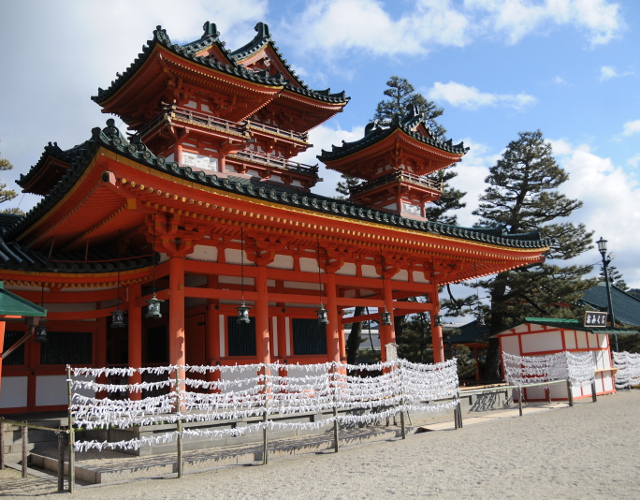 At the eastern and western end of the courtyard lie two towers called Soyru-ro (blue dragon tower) and Byakko-ro (white tiger tower), respectively. Those two animals are guardians of the east and west, and they also adorn two fountains nearby the entrance. Of course, there are also guardians of the north (Genbu, a black snake-turtle) and south (Suzaku, a vermillion bird). Images of the four animals can also be found on the iron lanterns present throughout the shrine.
At the eastern and western end of the courtyard lie two towers called Soyru-ro (blue dragon tower) and Byakko-ro (white tiger tower), respectively. Those two animals are guardians of the east and west, and they also adorn two fountains nearby the entrance. Of course, there are also guardians of the north (Genbu, a black snake-turtle) and south (Suzaku, a vermillion bird). Images of the four animals can also be found on the iron lanterns present throughout the shrine.
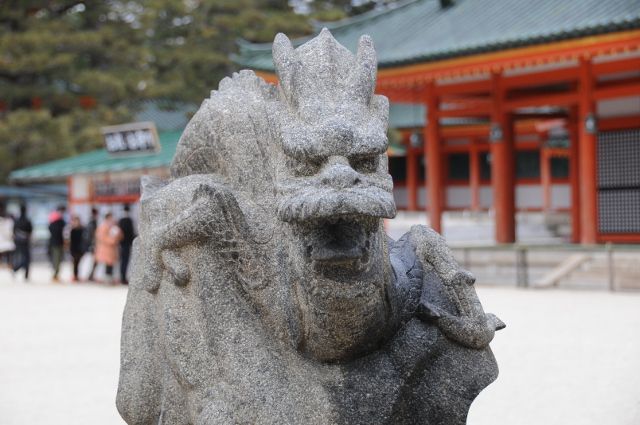 A very interesting feature of Heian Jingu is its large public garden, 33.000 square metres hidden behind the buildings. Construction on the Shinen Garden, which is divided into four parts, started in 1895, but it took 20 years to complete. Today, the entrance is at a gate at the western end of the courtyard, and directly behind it lies the South or Heian Garden, with some 200 species of plants that are mentioned in Heian era literature. It is also the resting place of Japan’s oldest street car that once ran through Kyoto.
A very interesting feature of Heian Jingu is its large public garden, 33.000 square metres hidden behind the buildings. Construction on the Shinen Garden, which is divided into four parts, started in 1895, but it took 20 years to complete. Today, the entrance is at a gate at the western end of the courtyard, and directly behind it lies the South or Heian Garden, with some 200 species of plants that are mentioned in Heian era literature. It is also the resting place of Japan’s oldest street car that once ran through Kyoto.
Further along the path lie the West, Middle, and Eastern Gardens. They were designed by famous Kyoto gardener Ueji VII (aka Jihei Ogawa), whose style is readily recognized. Unusual for a Shinto garden, Shinen is centered around large ponds that draw water from the Lake Biwa Canal, and are home to rare turtles and fish.
 In the West Garden, Byakko-Ike pond shows about 2000 Irises, representing the 200 species that grow in Japan. The Middle Garden follows with Soryu-ike pond that is crossed by stepping-stones called Garyuko. They were once part of old Sanjo and Gojo bridges built in the 16th century. However, the East Garden is the largest one, with Seiho-ike pond at its center, and many weeping cherries all over. The big attraction here is the covered bridge Taiheikaku, a gift from the imperial palace in the 1970s. The ceremonial hall Shobikan, that is reached after crossing the bridge, was also an imperial gift, today it is used for the weddings that take place at the shrine.
In the West Garden, Byakko-Ike pond shows about 2000 Irises, representing the 200 species that grow in Japan. The Middle Garden follows with Soryu-ike pond that is crossed by stepping-stones called Garyuko. They were once part of old Sanjo and Gojo bridges built in the 16th century. However, the East Garden is the largest one, with Seiho-ike pond at its center, and many weeping cherries all over. The big attraction here is the covered bridge Taiheikaku, a gift from the imperial palace in the 1970s. The ceremonial hall Shobikan, that is reached after crossing the bridge, was also an imperial gift, today it is used for the weddings that take place at the shrine.
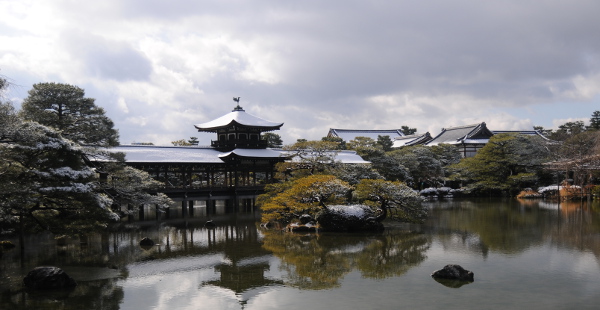 Heian Jingu is popular among tourists and locals alike. The gardens are a must-see in every season (although most famed during cherry blossoms) and the shrine itself is a popular destination for locals for their hatsumode visit or the Adult Day celebrations.
Heian Jingu is popular among tourists and locals alike. The gardens are a must-see in every season (although most famed during cherry blossoms) and the shrine itself is a popular destination for locals for their hatsumode visit or the Adult Day celebrations.
